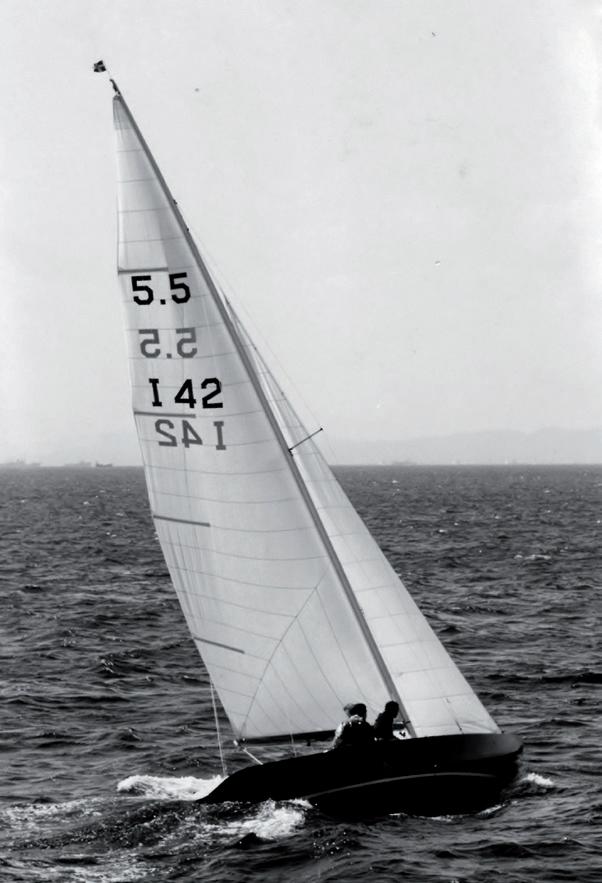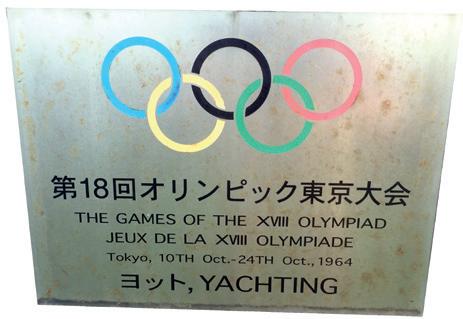
4 minute read
Enoshima 1964 Remembered

Being an Olympic year, i migh e no algic o look ack a he XVIII in 1964, he penul ima e ime he 5.5 Me re were pre en a Game . Tran la ed from an ar icle y ndre Rossi.
Advertisement
Olympi d he Olympic
In 2020 the Olympics are back in Enoshima, the scene of the historic Olympic victory by Australia’s Barrenjoey. The walls of the sailing centre there are endowed by memories of 1964, including several photos of the 5.5 Metres racing in Sagami Bay.
Tokyo was the host city while the sailing took place in Enoshima, a small isthmus south of Yokohama, where a new port was designed and equipped specially for the purpose of hosting the Games. At the time, Beppe Croce commented, “The port of Enoshima is certainly today the most beautiful and functional of the touristic and pleasure ports of the world: its mirrored waters of about thirty-five thousand square metres allow moorings of great comfort for many boats, ground installations, distributed over an area more or less impressive as the water mirror, they are almost perfect.”
Everything that could be planned, on the ground and on the water, to make the stay of the Olympic yachtsmen comfortable was undoubtedly done. What turned out to be


inadequate were the weather conditions of the entire week.
Two typhoons ‘Wilda’ and ‘Clara’ passed over Japan to coincide with the beginning and end of the Games, bringing periods of unpredictable wind and weather.
John McNamara, bronze medalist, commented: “The anemometer on a windy day of 23 knots of average, recorded wind jumps from 20 to 25 degrees, with a frequency from a minute and a half to two minutes; the data recording card looked like the electrocardiogram of the terminally sick.”
The design challenge, on the other hand, lost the global characteristics that had been found in Naples. The Japanese fleet was largely from the American design school with nine boats out of the (six by Bill Luders, two by Raymond Hunt,
Top: Start line in 1964 • Left: Rush VII, Web III and Chaje II • Above: Olympic monument in Enoshima • Above left: Winners plaque in Enoshima
one by Olin Stephens and one by the young Britton Chance Jr. The only European designed boat was from the expert Swedish designer Einar Ohlson, who had a good six boats at the start.
Ultimately, all the boats were presented at very high standards, all new or very new construction and specifically designed for this competition, which also included some inexperienced nations, such as Mexico.
Italy entered an Ohlson hull, I-42 Grifone, crewed by the Navy, which had dominated the season up to that point, imposing itself in the Genoa, Alassio and Cannes regattas. At the helm was the greatest Italian sailor of all times, Agostino ‘Tino’ Straulino, with Bruno Pretronio and Massimo Minervin as crew.
Enoshima was Straulino’s sixth Olympics, the first in the Class 5.5, but he already had two Star class medals (gold in Helsinki 1952 and silver in Melbourne 1956). Ever since he had started in the 5.5 Metre he reaped success by beating more experienced helmsmen in the class, and he was a clear favourite before the regatta began, but the races were influenced by bizarre meteorological conditions. The Italian team could only manage the leather medal, in fourth place.
During the seven races all possible weather conditions were tested: from calm to storm, with sun and rain that alternated with an unpredictable rhythm. The fight for the podiums was still fought over by the most experienced



crews: the American US 50, Bingo, blew the first race in really light winds and ended tenth and a protest against the race committee. They followed that with two race wins to finally end up with 10-1-1-6-2-3-DNF and the bronze medal.
The Swedish team on Rush VII Lars Thörn, Arne Karlsson and Sture Stork monopolised fourth place, with two race wins as well to end up second overall with a score of 4-4-4-4-1-4-1.
The outsiders, Barranjoey, from Australia, opened with a race win and maintained control through to the end. The team of Bill Northam, Peter O’Donnell and James Sargeant ended with a score of 1-6-2-1-DNF-1-4 to win gold by a substantial margin of more than 700 points.
However in the middle of the series it was still wide open for the medals. Grifone was the early leader, starting with a 2-2-3. The subsequent races were once again very difficult for weather conditions. Going into the last race Straulino had the chance to win the silver if the Italians took victory or the bronze if they managed to stay ahead of Sweden.
Finally the wind came from the south but the sea was high, conditions that suited the hulls of Luders (USA, Australia) and penalized the Ohlson (Sweden, Italy). Straulino and Thörn started well and seemed to have the race in hand, but the Luders went very well; on the last leg, not more than 500 meters from the finish line, Straulino seemed to have the game in hand, in a good position relative to the fleet and with a favourable wind.
Suddenly, a freak 30 degree shift shuffled the cards completely: the Swiss boat, never really in the regatta, recovered a dozen positions in a moment and moved up to second behind the Swedish (who won the silver). The American, in a risky manoeuvre, in a stroke lost gold and silver and took the bronze. Straulino eventually finished fifth in the race behind Barranjoey of Australia, which took the gold.










